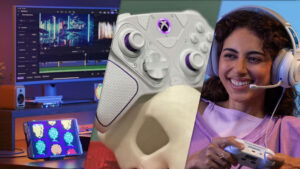In an age of rapid technological advancement, where screens dominate daily lives, it might seem surprising that board games and tabletop gaming are experiencing a renaissance. Yet, far from being left behind, these traditional forms of entertainment are embracing technology to offer players a bridge between the familiar and the cutting-edge.
Tech-enhanced board games and tabletop gaming represent a thrilling convergence of the physical and the digital realms, blending the tactile pleasure of rolling dice and moving pieces with the immersive possibilities of smartphones, augmented reality and companion apps.
The Digital Touch
The digital touch in board games is transforming the tactile experience, offering a dynamic fusion of physical components and digital wizardry. Whether it’s using smartphones or tablets as interactive game boards, employing augmented reality to bring game pieces to life, or integrating companion apps to enhance storytelling, technology is enriching the tactile nature of board games like never before.
It’s a captivating synergy that not only caters to long-time enthusiasts but also attracts new players, demonstrating that the appeal of gathering around a table for a board game night remains as strong as ever. And in this landscape of tech-infused board games, platforms like freeplay online casino sites exemplify how technology can reimagine classic casino games for the digital age, enhancing the tactile sensations of gaming and offering players a bridge between tradition and innovation.
Augmented Reality Adventures
Augmented reality (AR) is ushering in a new era of tabletop gaming, where the boundaries between the real and the digital blur to create captivating adventures. AR adventures transport players into richly layered, interactive worlds that seamlessly blend with their physical surroundings. Whether it’s exploring mythical realms, solving mysteries or battling fantastical creatures, AR transforms the tabletop into a stage for immersive storytelling.
Smart devices, equipped with AR capabilities, enable players to see, hear and interact with virtual elements overlaid on their real environment. This technology empowers tabletop role-playing games (RPGs) with dynamic visuals, enhancing the narrative and player engagement.
Enhancing Gameplay with Smart Devices
Smart devices are now more than just tools for communication; they have become integral components of the board gaming experience. Whether it’s solving mysteries, managing resources or tracking progress, these devices add a layer of convenience and immersion that transforms how people play.
Companion apps, synchronized with physical game components, provide real-time updates, generate complex scenarios and even serve as timers or scorekeepers. This integration not only streamlines rule-keeping but also opens up a world of possibilities, from interactive tutorials for newcomers to complex algorithms that adapt the game’s difficulty.
Accessibility and Inclusivity
In the past, board games were often limited by physical components, making them less accessible to individuals with disabilities or those who speak different languages. Today, tech-infused adaptations and companion apps are breaking down these barriers. Features such as voice-assisted gameplay, screen readers and customizable interfaces are empowering players with disabilities to fully engage in the gaming experience.
Also, translation apps and digital rulebooks are bridging language gaps, allowing players from diverse backgrounds to enjoy games that were once language-dependent. Furthermore, the rise of online multiplayer modes and digital platforms has made it easier for individuals with varying schedules and geographical locations to participate in board gaming communities.
Challenges and Future Directions
As tech-enhanced board gaming continues to evolve, it faces both exciting possibilities and significant challenges. On the one hand, technology has the potential to elevate board gaming to new heights by enhancing immersion, accessibility and gameplay. Augmented reality, companion apps and online multiplayer options are just the beginning of what’s possible.
One of the foremost challenges is finding the delicate balance between traditional tactile experiences and the integration of technology. Many board game enthusiasts cherish the physicality of rolling dice, moving pieces and interacting with the game board. Striking the right equilibrium between digital and analog elements is essential to preserving the essence of board gaming.



